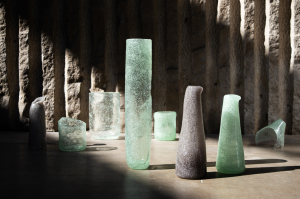Glass is often seen as sustainable, because it can be recycled endlessly and it is one of the few materials where it works almost worldwide. But if you look closer, it’s not that easy. In addition to a high level of hidden energy, various ingredients are required that are mostly problematic. This glass is a first step towards improvement.
In addition to sand, glass usually requires two other main components: Sodium and Calcium Carbonate. As with most industrial processes, the availability of these ingredients is changing dramatically due to climate change and human production methods.
Sodium as a flux is extracted in salt lakes and manufactured using the Solvay process, which requires a high level of water and energy as well as quicklime: Rare limestone heated to 1000° C. Energy consumption that is completely overlooked in the case of glass. On top of that, many natural salt lakes are shrinking rapidly due to global warming.
Limestone as a hardener is removed in large mines to get Calcium Carbonate. Limestone was formed over hundreds of millions of years and there is an annual usage of 5000 million tons of limestone. The largest mine in Europe will be exhausted in 2048 and others will follow.
This new glass discovers infinite supply chains by using waste which has no value so far: Wood ash from pizza bakeries and shells from seafood restaurants. These renewable raw materials are available in large quantities in many cities and have so far been thrown away.



